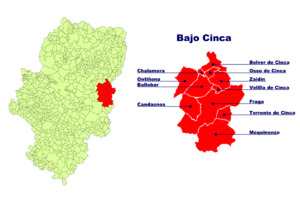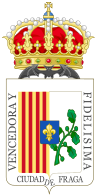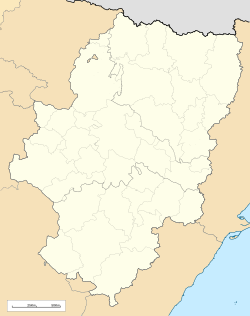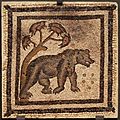Fraga facts for kids
Quick facts for kids
Fraga
|
|||
|---|---|---|---|
 |
|||
|
|||
 |
|||
| Country | |||
| Autonomous community | |||
| Province | Huesca | ||
| Comarca | Bajo Cinca | ||
| Judicial district | Fraga | ||
| Area | |||
| • Total | 437.64 km2 (168.97 sq mi) | ||
| Elevation | 118 m (387 ft) | ||
| Population
(2018)
|
|||
| • Total | 14,979 | ||
| • Density | 34.2268/km2 (88.647/sq mi) | ||
| Demonyms | Fragatino, -na Fraguense | ||
| Time zone | UTC+1 (CET) | ||
| • Summer (DST) | UTC+2 (CEST) | ||
| Postal code |
22520
|
||
Fraga is a large town in the Huesca province of Aragon, Spain. It is the main town of a region called Bajo Cinca (which means Lower Cinca). Fraga is located right next to the Cinca River. In 2014, about 14,926 people lived there.
A long time ago, in 1134, King Alfonso I of Aragon died near Fraga while trying to capture it during the Battle of Fraga. Later, in 1149, Count Ramon Berenguer IV of Barcelona successfully took control of Fraga from the Moors.
The language spoken by the local people in Fraga is called Fragatí. It is a type of Catalan.
Historically, Fraga was home to a Jewish community. Unlike in some other places, Jewish people in Fraga had many civil rights. They could protect themselves and choose their own leaders. This community ended in 1492 when Jewish people were asked to leave Spain.
Contents
Fraga's Past: A Historical Journey
Fraga has a rich history with many important events. Let's explore some of them.
Early History and Conquests
As mentioned, King Alfonso I of Aragon tried to conquer Fraga but died in battle. Later, Ramon Berenguer IV of Barcelona successfully took the town. These events shaped Fraga's early development.
Fraga During the Spanish Civil War
During the Spanish Revolution of 1936, Fraga was managed by a group called anarcho-syndicalists from the CNT. They made many changes to improve life in the town.
- They organized collective farming, where people worked together on farms.
- They set up price controls to make sure food and goods were fair.
- They introduced wartime rationing to share resources equally.
- They offered interest-free banking to help people with money.
- They started sanitation programs to keep the town clean and healthy.
- They worked on public works projects, like building things for the community.
- They even did tree planting to make the town greener.
- They also opened a nursing home for elderly people.
- The town hospital grew from 20 beds to 100.
- For the first time, the hospital got running water to help fight diseases like Typhus.
These efforts show how the community worked together during a difficult time.
Historical Sights in Fraga
Fraga has several interesting historical places to visit. These sites tell stories about the town's past.
Population Changes Over Time
The number of people living in Fraga has changed a lot over the years. This section shows how the population has grown and shrunk.
Population Evolution Chart
This chart shows the population of Fraga from 1910 to 2018.

Population Trend Table
This table shows the population numbers for specific years between 1991 and 2018.
| Population trend between 1991 and 2018 | ||||||
|---|---|---|---|---|---|---|
| 1991 | 1996 | 2001 | 2004 | 2006 | 2013 | 2018 |
| 11491 | 11783 | 12100 | 13035 | 13191 | 14834 | 14979 |
Famous People from Fraga
Some notable individuals have come from Fraga:
- Astruc Remoch: A well-known scholar who was once Jewish and later converted to Christianity.
- Ceferino Giménez Malla: A Spanish Romani activist who worked for his community's rights.
- Lourdes Casanova: A respected academic and professor.
See also
 In Spanish: Fraga (Huesca) para niños
In Spanish: Fraga (Huesca) para niños














